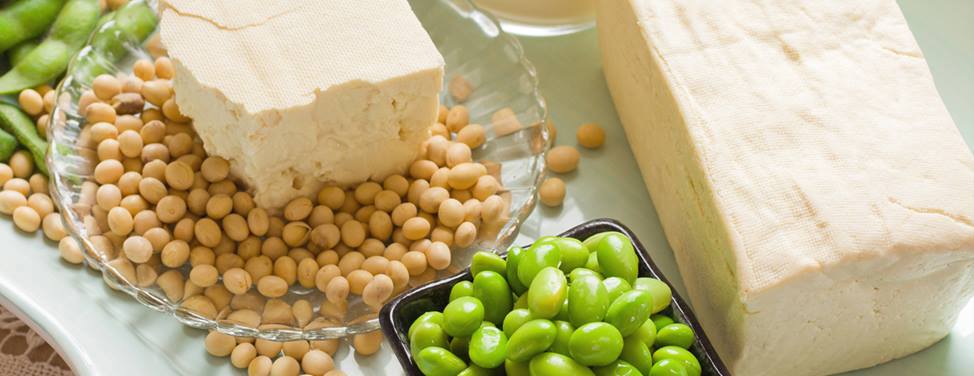
A Guide to Foods Rich in Soy
The following is a list of foods containing soy.
Edamame
These soybeans are harvested when the beans are still green and sweet tasting. They can be served as a snack or a main vegetable, after boiling in slightly salted water for 15 to 20 minutes. They are high in protein and fiber and contain no cholesterol. Edamame can be bought shelled or in the pod in the supermarket produce section or frozen food aisle.
Meat Alternatives
Meat alternatives, containing soy protein or tofu, are used to imitate meat, such as burgers, sausages, bacon and hot dogs. Generally, they are cholesterol-free and lower in fat than meat. They are excellent sources of protein, iron and B vitamins.
Miso
Miso is a rich, salty soy paste used in Japanese cooking. The Japanese make miso soup and use miso to flavor a variety of foods such as sauces, dressings and marinades. Miso paste should be refrigerated. Miso contains minimal soy protein and is high in sodium.
Soymilk
Soybeans that are soaked, ground fine and strained produce fluid called soybean milk. Plain, unfortified soymilk is an excellent source of high quality protein and B vitamins, but lacks calcium and vitamin D. Fortified versions, however, are available.
Soymilk can be found in non-refrigerated containers or in the dairy case at the supermarket. It also is sold as a powder to be mixed with water.
Soymilk is an excellent milk substitute for people who are lactose intolerant. It can used as a beverage or in place of milk in cooking.
Soy Nuts
Roasted soy nuts are whole soybeans that have been soaked in water and then baked until browned. Soy nuts come in a variety of flavors. They are high in protein and isoflavones, and similar in texture and flavor to peanuts.
Soy Sauce (Tamari, Shoyu and Teriyaki)
Soy sauce is a dark brown liquid made from soybeans that have undergone a fermenting process. Soy sauce contains minimal soy protein and is high in salt.
Two types of soy sauce are shoyu and tamari. Shoyu is a blend of soybeans and wheat. Tamari is made only from soybeans and is a by-product of miso. Another sauce containing soy sauce is teriyaki sauce. It contains soy sauce and other ingredients such as sugar, vinegar and spices.
Tempeh
Tempeh is a chunky, tender soybean product. Whole soybeans, sometimes mixed with another grain such as rice or millet, are fermented and pressed into a cake or bar with a smoky or nutty flavor. It can be sliced, marinated and grilled, and added to soups, casseroles or chili. It is found in Asian and health food stores.
Textured Soy Protein
Textured soy protein (TSP) refers to products made from textured soy flour, textured soy protein concentrates and spun soy fiber. Textured soy flour contains about 70 percent protein and retains most of the bean's dietary fiber. Textured soy flour is sold dried in granular and chunk style. When hydrated, it has a chewy texture. It is widely used as a meat extender. One of the more popular brands is called Textured Vegetable Protein (TVP).
Tofu
Tofu, also known as soybean curd, is a soft, smooth soy product made by curdling fresh, hot soymilk with coagulant. Tofu has a mild flavor and easily absorbs the flavors of marinades, spices and other ingredients. Tofu is rich in high-quality protein and B vitamins, and low in sodium. There are two main types of tofu:
- Water-packed tofu comes in extra-firm, firm and soft varieties. This tofu is dense and solid and holds up well in stir fry dishes and soups, on the grill or anywhere you want tofu to maintain its shape.
- Silken tofu comes in extra-firm, firm, soft and reduced-fat varieties. This tofu is made by a slightly different process that results in softer product. Silken tofu works well in pureed or blended dishes.
Whole Soybeans
As soybeans mature in the pod, they ripen into a hard, dry bean, similar to other legumes. Most mature soybeans are yellow, but some are brown and black.
Whole soybeans are an excellent source of protein and dietary fiber. They can be cooked and used in sauces, stews, and soups. Whole soybeans that have been soaked can be roasted for snacks and are available in natural food stores and some supermarkets. When grown without chemicals, they are referred to as organically grown soybeans.
UCSF Health medical specialists have reviewed this information. It is for educational purposes only and is not intended to replace the advice of your doctor or other health care provider. We encourage you to discuss any questions or concerns you may have with your provider.










